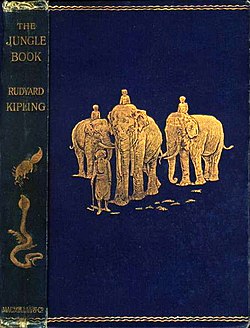Book Summary
Rudyard Kipling’s The Jungle Book (1894) is a collection of seven stories, only three of which focus on Mowgli, the “man-cub” raised by wolves in the Indian jungle. Far from Disney’s lighthearted musical, Kipling’s original tales are steeped in the brutal “Law of the Jungle,” where survival hinges on violence and cunning. Mowgli’s journey—guided by Baloo the bear and Bagheera the panther—culminates in a climactic showdown with the tiger Shere Khan, but the book also includes standalone stories like “Rikki-Tikki-Tavi” and “The White Seal,” blending fable with colonial-era realism.
Kipling’s prose oscillates between lyrical beauty and unsettling savagery. The jungle is vividly rendered, with its own moral code (“For the strength of the Pack is the Wolf, and the strength of the Wolf is the Pack”), but modern readers may struggle with dated stereotypes and corporal punishment scenes. While Mowgli’s arc remains compelling, the non-Mowgli stories feel uneven—some, like “Her Majesty’s Servants,” drag with military anecdotes, while others, like “Toomai of the Elephants,” enchant with their mythic quality.
Key Themes
Nature vs. Civilization: Kipling contrasts the jungle’s harsh but honest hierarchy with human hypocrisy. Mowgli’s dual identity—neither fully wolf nor man—mirrors colonial tensions, as he wields human ingenuity (fire, tools) to dominate the jungle. Yet the ending hints at alienation; Mowgli outgrows both worlds, a critique of imperialist notions of belonging.
Moral Ambiguity: The “Law of the Jungle” glorifies survivalist ethics, but Kipling undercuts this with moments of tenderness, like Baloo’s gruff mentorship. However, the colonial subtext is unavoidable—especially in stories like “The White Seal,” where animals submit to human dominion, reflecting Kipling’s controversial “White Man’s Burden” ideology.
What Makes It Unique
Kipling’s fusion of myth and realism was groundbreaking. The jungle operates as a microcosm of human society, complete with politics (the Wolf Pack’s councils) and social stratification (Shere Khan as the outlaw). Unlike later sanitized adaptations, Kipling doesn’t shy from bloodshed—Mowgli skins Shere Khan alive, and Kaa the python hypnotizes prey before consuming them.
The book’s structural experimentation also stands out. Interwoven poems and shifting perspectives (from Mowgli to a seal to a mongoose) create a mosaic narrative. While this disjointedness frustrates some readers, it mirrors the jungle’s chaotic diversity. The 1990s Talespin cartoon and 2016 live-action film borrowed elements but lost Kipling’s layered commentary.
Reader Reactions
Reviews are polarized. Many praise its immersive worldbuilding: I felt myself hearing the strange noises, feeling the ground slither with snakes
. Others critique its pacing: I spent twenty minutes on one set of pages just to grasp the narrative
. Parents note discomfort with Baloo’s corporal punishment (“love taps” that feel like abuse) and racial stereotypes, though some argue these spark valuable discussions about historical context.
Audiobook listeners highlight Gildart Jackson’s narration as transformative: He breathed life into the jungle’s vibrancy
. Meanwhile, fans of the Mowgli stories often express disappointment with the anthology’s scope: Only three chapters are about Mowgli—the rest are forgettable
.
About the Author
Rudyard Kipling (1865–1936), born in British India, was the youngest Nobel Literature laureate. His childhood in colonial Lahore infused his work with exoticism and imperialist biases, evident in The Jungle Book‘s portrayal of “native” passivity. A journalist by trade, Kipling’s crisp prose and folkloric style made him a literary superstar, though later critics condemned his jingoism (e.g., “The White Man’s Burden”).
Kipling’s personal tragedies—including his son’s WWI death—shadow his later works, but The Jungle Book remains his most accessible. Its themes of belonging and survival resonate with children, while adults grapple with its colonial legacy. Modern readers might prefer Neil Gaiman’s The Graveyard Book for a progressive retelling.
Memorable Quotes
For the strength of the Pack is the Wolf, and the strength of the Wolf is the Pack.
Let them fall, Mowgli. They are only tears.
